
Human Anatomy Lab Manual is shared under a CC BY-NC-SA 4.0 license and was authored, remixed, and/or curated by LibreTexts..
- Subject:
- Anatomy/Physiology
- Life Science
- Material Type:
- Activity/Lab
- Provider:
- LibreTexts
- Date Added:
- 07/19/2023

Human Anatomy Lab Manual is shared under a CC BY-NC-SA 4.0 license and was authored, remixed, and/or curated by LibreTexts..

This text been designed for an undergraduate human anatomy and physiology course at a medium sized public university. This text has been modified from the original OpenStax text to encourage more active reading for an early undergraduate student taking the first semester of a year-long human anatomy and physiology course sequence. This text has been targeted to our student population, consisting primarily of first semester pre-nursing and kinesiology majors at a university with a high proportion of first generation and PELL-eligible students who benefit from lower barriers to entry into the field. Therefore, freely-available and differently presented text can be beneficial to this student population. This version was designed with the intention of distributing it section by section through a learning management system. If this mode of distribution is used, connection to an assessment tool could be utilized. Systems covered include skeletal, muscular, cardiovascular, respiratory, and nervous.
As this text reorganizes and modifies an OpenStax’s Anatomy and Physiology 2e (see related resources link below), chapter numbers and chapter section numbers from the original have been preserved in this document. Material supplemented from other sources is cited within the text.
Course connections: Undergraduate courses aimed towards freshmen or sophomore, including Anatomy and Physiology, Introduction to Anatomy and Physiology, Physiology, Introduction to Physiology, Human Biology or similar with a human focus.

The Nervous System Student Edition book is one of ten volumes making up the Human Biology curriculum, an interdisciplinary and inquiry-based approach to the study of life science.
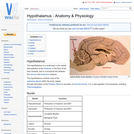
The hypothalamus is a small area in the ventral diencephalon of the forebrain, in the floor of the third ventricle, and is a functional link between the nervous and endocrine systems.

The MIT Biology Department core courses, 7.012, 7.013, and 7.014, all cover the same core material, which includes the fundamental principles of biochemistry, genetics, molecular biology, and cell biology. Biological function at the molecular level is particularly emphasized and covers the structure and regulation of genes, as well as, the structure and synthesis of proteins, how these molecules are integrated into cells, and how these cells are integrated into multicellular systems and organisms. In addition, each version of the subject has its own distinctive material.
7.012 focuses on the exploration of current research in cell biology, immunology, neurobiology, genomics, and molecular medicine.
Acknowledgments
The study materials, problem sets, and quiz materials used during Fall 2004 for 7.012 include contributions from past instructors, teaching assistants, and other members of the MIT Biology Department affiliated with course #7.012. Since the following works have evolved over a period of many years, no single source can be attributed.

The MIT Biology Department core Introductory Biology courses, 7.012, 7.013, 7.014, 7.015, and 7.016 all cover the same core material, which includes the fundamental principles of biochemistry, genetics, molecular biology, and cell biology. The focus of 7.013 is on genomic approaches to human biology, including neuroscience, development, immunology, tissue repair and stem cells, tissue engineering, and infectious and inherited diseases, including cancer.

The MIT Biology Department core courses, 7.012, 7.013, and 7.014, all cover the same core material, which includes the fundamental principles of biochemistry, genetics, molecular biology, and cell biology. 7.013 focuses on the application of the fundamental principles toward an understanding of human biology. Topics include genetics, cell biology, molecular biology, disease (infectious agents, inherited diseases and cancer), developmental biology, neurobiology and evolution.
Biological function at the molecular level is particularly emphasized in all courses and covers the structure and regulation of genes, as well as, the structure and synthesis of proteins, how these molecules are integrated into cells, and how these cells are integrated into multicellular systems and organisms. In addition, each version of the subject has its own distinctive material.

The MIT Biology Department core courses, 7.012, 7.013, and 7.014, all cover the same core material, which includes the fundamental principles of biochemistry, genetics, molecular biology, and cell biology. Biological function at the molecular level is particularly emphasized and covers the structure and regulation of genes, as well as, the structure and synthesis of proteins, how these molecules are integrated into cells, and how these cells are integrated into multicellular systems and organisms. In addition, each version of the subject has its own distinctive material.
7.014 focuses on the application of these fundamental principles, toward an understanding of microorganisms as geochemical agents responsible for the evolution and renewal of the biosphere and of their role in human health and disease.
Acknowledgements
The study materials, problem sets, and quiz materials used during Spring 2005 for 7.014 include contributions from past instructors, teaching assistants, and other members of the MIT Biology Department affiliated with course 7.014. Since the following works have evolved over a period of many years, no single source can be attributed.

Students are introduced to various types of hearing impairments and the types of biomedical devices that engineers have designed to aid people with this physical disability.

This lesson describes the function and components of the human nervous system. It helps students understand the purpose of our brain, spinal cord, nerves and the five senses. How the nervous system is affected during spaceflight is also discussed in this lesson.

This resource is a video abstract of a research paper created by Research Square on behalf of its authors. It provides a synopsis that's easy to understand, and can be used to introduce the topics it covers to students, researchers, and the general public. The video's transcript is also provided in full, with a portion provided below for preview:
"Could doctors one day prescribe electrical stimulation to fight a bacterial infection? Work by an interdisciplinary team of researchers at AIMES suggests that might be possible. In line with the Goals of the United Nations’ 2030 Agenda, researchers at AIMES are dedicated to promoting “Good Health and Well-Being” by achieving a better understanding of bacterial infections and the body’s defenses against them. Some of their latest findings reveal a new aspect of host–pathogen interactions. In addition to the cascade of chemical signals that are activated when bacteria invade, the body might also conduct electrical signals across nerves—enabling the infected organ to call distant parts of the body to action. The team uncovered this form of “biological telecommunication” by studying rats with kidney infections caused by strains of E. coli. Within as little as 4 hours of infection, they could detect an immune response all the way in the spleen..."
The rest of the transcript, along with a link to the research itself, is available on the resource itself.
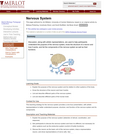
This learning strategy provides discussion and visualizations of the neuron and its function, as well as components and functions of different parts of the nervous system, including the human brain.
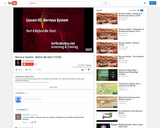
The nervous system is a huge lesson. In previous lessons we looked at the histology of the nervous system. This video discusses how the rest of the nervous system will be covered.
Lesson 8 in our Nervous System series. This is part of our Anatomy and Physiology lecture series.
If this video helps you please be sure to LST -like subscribe and tell your friends. Your support help us make more videos. For the complete series please visit http://mrfordsclass.net/
Videos in the skeletal system series:
- Introduction (10:01): http://youtu.be/HX1bsdHLC58
- Neurons (10:02): http://youtu.be/-AcQI5MQhLU
- Classification of Neurons (10:03): http://youtu.be/PoqzDE_OLsQ
- Neuroglia Cells (10:04): http://youtu.be/stqdNMc6-Jk
- Before We Start (10:08): http://youtu.be/E8K_W8c_c-M
- Divisions of the Nervous System (10:09): http://youtu.be/kEJkYkF6nMc
- Components of the Central Nervous System (10:10): http://youtu.be/IwofyN198YU
- The Cerebrum (10:11): http://youtu.be/VLt3jigsMAU
- Lobes of the Cerebrum (10:12): http://youtu.be/Zc__B_sOA-Q
- Functional Areas of the Brain (10:13): http://youtu.be/sjbZ9QGyBi8

Continuing our look at the nervous system, we take a survey of the components of the central nervous system. Covered in this video: Cerebrum, Cerebellum, Brainstem and the spinal cord.
Lesson 10 in our Nervous System series. This is part of our Anatomy and Physiology lecture series.
If this video helps you please be sure to LST -like subscribe and tell your friends. Your support help us make more videos. For the complete series please visit http://mrfordsclass.net/
Videos in the skeletal system series:
- Introduction (10:01): http://youtu.be/HX1bsdHLC58
- Neurons (10:02): http://youtu.be/-AcQI5MQhLU
- Classification of Neurons (10:03): http://youtu.be/PoqzDE_OLsQ
- Neuroglia Cells (10:04): http://youtu.be/stqdNMc6-Jk
- Before We Start (10:08): http://youtu.be/E8K_W8c_c-M
- Divisions of the Nervous System (10:09): http://youtu.be/kEJkYkF6nMc
- Components of the Central Nervous System (10:10): http://youtu.be/IwofyN198YU
- The Cerebrum (10:11): http://youtu.be/VLt3jigsMAU
- Lobes of the Cerebrum (10:12): http://youtu.be/Zc__B_sOA-Q
- Functional Areas of the Brain (10:13): http://youtu.be/sjbZ9QGyBi8
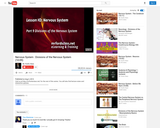
We start our look at the nervous system by looking at the divisions. We go over the central and peripheral nervous system. Looking further at the somatic nervous system and the autonomic nervous system and finally the sympathetic and parasympathetic divisions.
Lesson 9 in our Nervous System series. This is part of our Anatomy and Physiology lecture series.
If this video helps you please be sure to LST -like subscribe and tell your friends. Your support help us make more videos. For the complete series please visit http://mrfordsclass.net/
Videos in the skeletal system series:
- Introduction (10:01): http://youtu.be/HX1bsdHLC58
- Neurons (10:02): http://youtu.be/-AcQI5MQhLU
- Classification of Neurons (10:03): http://youtu.be/PoqzDE_OLsQ
- Neuroglia Cells (10:04): http://youtu.be/stqdNMc6-Jk
- Before We Start (10:08): http://youtu.be/E8K_W8c_c-M
- Divisions of the Nervous System (10:09): http://youtu.be/kEJkYkF6nMc
- Components of the Central Nervous System (10:10): http://youtu.be/IwofyN198YU
- The Cerebrum (10:11): http://youtu.be/VLt3jigsMAU
- Lobes of the Cerebrum (10:12): http://youtu.be/Zc__B_sOA-Q
- Functional Areas of the Brain (10:13): http://youtu.be/sjbZ9QGyBi8
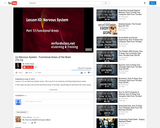
In this video we take a look at the functional areas of the brain. Specifically we talk about the motor areas, sensory areas, and association areas. We touch briefly on the Broca's Area and Wernicke's area.
Lesson 13 in our Nervous System series. This is part of our Anatomy and Physiology lecture series.
If this video helps you please be sure to LST -like subscribe and tell your friends. Your support help us make more videos. For the complete series please visit http://mrfordsclass.net/
Videos in the skeletal system series:
- Introduction (10:01): http://youtu.be/HX1bsdHLC58
- Neurons (10:02): http://youtu.be/-AcQI5MQhLU
- Classification of Neurons (10:03): http://youtu.be/PoqzDE_OLsQ
- Neuroglia Cells (10:04): http://youtu.be/stqdNMc6-Jk
- Before We Start (10:08): http://youtu.be/E8K_W8c_c-M
- Divisions of the Nervous System (10:09): http://youtu.be/kEJkYkF6nMc
- Components of the Central Nervous System (10:10): http://youtu.be/IwofyN198YU
- The Cerebrum (10:11): http://youtu.be/VLt3jigsMAU
- Lobes of the Cerebrum (10:12): http://youtu.be/Zc__B_sOA-Q
- Functional Areas of the Brain (10:13): http://youtu.be/sjbZ9QGyBi8
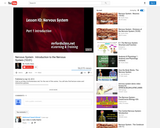
We begin our study of the nervous system by introducing a few concepts and laying out the rest of the series. We look at the: Components of the nervous system and Functions of the nervous system.
Lesson 1 in our Nervous System series. This is part of our Anatomy and Physiology lecture series.
If this video helps you please be sure to LST -like subscribe and tell your friends. Your support help us make more videos. For the complete series please visit http://mrfordsclass.net/
Videos in the skeletal system series:
- Introduction (10:01): http://youtu.be/HX1bsdHLC58
- Neurons (10:02): http://youtu.be/-AcQI5MQhLU
- Classification of Neurons (10:03): http://youtu.be/PoqzDE_OLsQ
- Neuroglia Cells (10:04): http://youtu.be/stqdNMc6-Jk
- Before We Start (10:08): http://youtu.be/E8K_W8c_c-M
- Divisions of the Nervous System (10:09): http://youtu.be/kEJkYkF6nMc
- Components of the Central Nervous System (10:10): http://youtu.be/IwofyN198YU
- The Cerebrum (10:11): http://youtu.be/VLt3jigsMAU
- Lobes of the Cerebrum (10:12): http://youtu.be/Zc__B_sOA-Q
- Functional Areas of the Brain (10:13): http://youtu.be/sjbZ9QGyBi8

Continuing our look at the brain, we focus on the lobes of the cerebrum: frontal lobe, parietal lobe, temporal lobe, occipital lobe, and the insular.
Lesson 12 in our Nervous System series. This is part of our Anatomy and Physiology lecture series.
If this video helps you please be sure to LST -like subscribe and tell your friends. Your support help us make more videos. For the complete series please visit http://mrfordsclass.net/
Videos in the skeletal system series:
- Introduction (10:01): http://youtu.be/HX1bsdHLC58
- Neurons (10:02): http://youtu.be/-AcQI5MQhLU
- Classification of Neurons (10:03): http://youtu.be/PoqzDE_OLsQ
- Neuroglia Cells (10:04): http://youtu.be/stqdNMc6-Jk
- Before We Start (10:08): http://youtu.be/E8K_W8c_c-M
- Divisions of the Nervous System (10:09): http://youtu.be/kEJkYkF6nMc
- Components of the Central Nervous System (10:10): http://youtu.be/IwofyN198YU
- The Cerebrum (10:11): http://youtu.be/VLt3jigsMAU
- Lobes of the Cerebrum (10:12): http://youtu.be/Zc__B_sOA-Q
- Functional Areas of the Brain (10:13

We continue our look at the Nervous System with the neuroglia cells: Astrocytes, Oligodendrocytes, Microglial cells and Ependyma.
Lesson 4 in our Nervous System series. This is part of our Anatomy and Physiology lecture series.
If this video helps you please be sure to LST -like subscribe and tell your friends. Your support help us make more videos. For the complete series please visit http://mrfordsclass.net/
Videos in the skeletal system series:
- Introduction (10:01): http://youtu.be/HX1bsdHLC58
- Neurons (10:02): http://youtu.be/-AcQI5MQhLU
- Classification of Neurons (10:03): http://youtu.be/PoqzDE_OLsQ
- Neuroglia Cells (10:04): http://youtu.be/stqdNMc6-Jk
- Before We Start (10:08): http://youtu.be/E8K_W8c_c-M
- Divisions of the Nervous System (10:09): http://youtu.be/kEJkYkF6nMc
- Components of the Central Nervous System (10:10): http://youtu.be/IwofyN198YU
- The Cerebrum (10:11): http://youtu.be/VLt3jigsMAU
- Lobes of the Cerebrum (10:12): http://youtu.be/Zc__B_sOA-Q
- Functional Areas of the Brain (10:13): http://youtu.be/sjbZ9QGyBi8
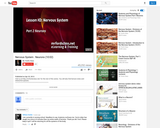
We take a look at the nerve cells, the components of a neuron: dendrites, cell bodies, and axons.
The concepts covered in this video include:
•Neurons
•Parts of the neuron
•Axonal transport
Lesson 2 in our Nervous System series. This is part of our Anatomy and Physiology lecture series.
If this video helps you please be sure to LST -like subscribe and tell your friends. Your support help us make more videos. For the complete series please visit http://mrfordsclass.net/
Videos in the skeletal system series:
- Introduction (10:01): http://youtu.be/HX1bsdHLC58
- Neurons (10:02): http://youtu.be/-AcQI5MQhLU
- Classification of Neurons (10:03): http://youtu.be/PoqzDE_OLsQ
- Neuroglia Cells (10:04): http://youtu.be/stqdNMc6-Jk
- Before We Start (10:08): http://youtu.be/E8K_W8c_c-M
- Divisions of the Nervous System (10:09): http://youtu.be/kEJkYkF6nMc
- Components of the Central Nervous System (10:10): http://youtu.be/IwofyN198YU
- The Cerebrum (10:11): http://youtu.be/VLt3jigsMAU
- Lobes of the Cerebrum (10:12): http://youtu.be/Zc__B_sOA-Q
- Functional Areas of the Brain (10:13): http://youtu.be/sjbZ9QGyBi8